

Dogs suffer from many of the same physical illnesses as people. They might even share many of the same psychological problems. Since people usually know more about human diseases than canine maladies, many of the terms used in this chapter will be familiar but not necessarily those used by veterinarians. We will use the term x-ray, instead of the more acceptable term radiograph. We will also use the familiar term symptoms even though dogs don’t have symptoms, which are verbal descriptions of the patient’s feelings; dogs have clinical signs. Since dogs can’t speak, we have to look for clinical signs…but we still use the term symptoms in this book.
As a general rule, medicine is practiced. That term is not arbitrary. Medicine is a constantly changing art as we learn more and more about genetics, electronic aids (like CAT scans and MRI scans) and daily laboratory advances. There are many dog maladies, like canine hip dysplasia, which are not universally treated in the same manner. For example, some veterinarians opt for surgical treatment more often than others do.

Before you buy a dog, meet and interview the vets in your area. Take everything into consideration: discuss background, specialties, fees, emergency policies, etc.
Your selection of a veterinarian should be based upon his skills with dogs and personality, as well as upon convenience to your home. You want a vet who is close because you might have emergencies or need to make multiple visits for treatments. You want a vet who has services that you might require such as tattooing and boarding facilities, and of course a good reputation for ability and responsiveness. There is nothing more frustrating than having to wait a day or more to get a response from your veterinarian.
Internal Organs of the Pembroke Welsh Corgi

All veterinarians are licensed and should be capable of dealing with routine health issues. There are, however, many veterinary specialties that require further studies and internships. These include specialists in heart problems (veterinary cardiologists), skin problems (veterinary dermatologists), teeth and gum problems (veterinary dentists), eye problems (veterinary ophthalmologists) and x-rays (veterinary radiologists), as well as vets who have specialties in bones, muscles or certain organs. If your dog is suffering from a condition that requires the help of a specialist, your veterinarian will refer you to someone in the appropriate field.
When the problem affecting your dog is serious, it is not unusual or impudent to get another medical opinion, although it is courteous to advise the vets concerned about this. You might also want to compare costs amongst several veterinarians. Sophisticated health care and veterinary services can be very costly. If there is more than one treatment option, cost can be a factor in choosing which route to take.
NEUTERING/SPAYING
Male dogs are castrated. The operation removes both testicles and requires that the dog be anesthetized. Recovery takes about one week. Females are spayed; in this operation, the uterus (womb) and both of the ovaries are removed. This is major surgery, also carried out under general anesthesia, and it usually takes a bitch two weeks to recover.
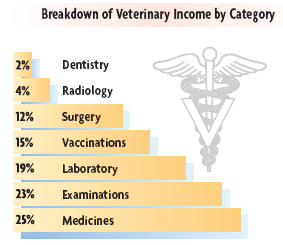
A typical vet’s income, categorized according to services performed. This survey dealt with small-animal (pets) practices.
It is much easier, less costly and more effective to practice preventative medicine than to fight bouts of illness and disease. Properly bred puppies come from parents that were selected based upon their genetic-disease profiles. Their mothers should have been vaccinated, free of all internal and external parasites and properly nourished. For these reasons, a visit to the veterinarian who cared for the dam is recommended. The dam can pass on disease resistance to her puppies, which can last for eight to ten weeks. She can also pass on parasites and many infections. That’s why you should learn as much as possible about the dam’s health.
Skeletal Structure of the Pembroke Welsh Corgi

PUPPY VACCINATIONS
Your veterinarian will probably recommend that your puppy be fully vaccinated before you take him outside. There are airborne diseases, parasite eggs in the grass and unexpected visits from other dogs that might be dangerous to your puppy’s health. Other dogs are the most harmful reservoir of pathogenic organisms, as everything they have can be transmitted to your puppy.
While vaccinations help prevent your new puppy from contracting diseases, they do not cure them. Proper nutrition as well as parasite control keep your dog healthy and less susceptible to many dangerous diseases. Remember that your dog depends on you to ensure his well-being.
Most vaccinations are given by injection and should only be done by a veterinarian. Both he and you should keep a record of the date of the injection, the identification of the vaccine and the amount given. Some vets give a first vaccination at six weeks, but most dog breeders prefer the course not to commence until about eight weeks because of negating any antibodies passed on by the dam. The vaccination scheduling is usually based on a two- to four-week cycle. You must take your vet’s advice regarding when to vaccinate as this may differ according to the vaccine used.
Most vaccinations immunize your puppy against viruses. The usual vaccines contain immunizing doses of several different viruses such as distemper, parvovirus, parainfluenza and hepatitis. There are other vaccines available when the puppy is at risk. You should rely upon professional advice. This is especially true for the booster-shot program. Most vaccination programs require a booster when the puppy is a year old and once a year thereafter. In some cases, circumstances may require more or less frequent immunizations.
Canine cough, more formally known as tracheobronchitis, is treated with a vaccine that is sprayed into the dog’s nostrils. Canine cough is usually included in routine vaccination, but this is often not as effective as the vaccines for other major diseases.
Puppies should be weaned by the time they are about two months old. A puppy that remains for at least eight weeks with his mother and littermates usually adapts better to other dogs and people later in his life.
Sometimes new owners have their puppy examined by a veterinarian immediately, which is a good idea unless the pup is overtired from the journey home from the breeder. In that case, an appointment should be arranged for the next day.
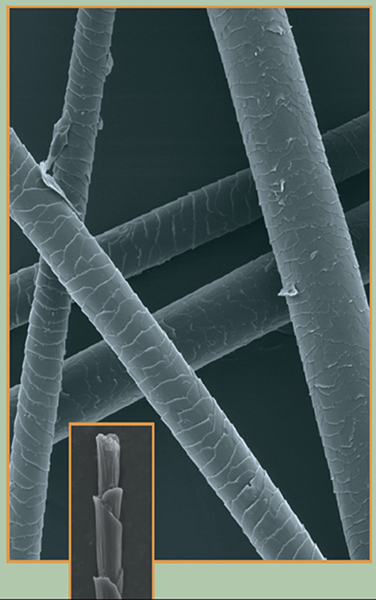
S.E.M. BY DR. DENNIS KUNKEL, UNIVERSITY OF HAWAII
Normal hairs of a dog enlarged 200 times original size. The cuticle (outer covering) is clean and healthy. Unlike human hair that grows from the base, a dog’s hair also grows from the end, as shown in the inset.
The puppy will have his teeth examined and have his skeletal conformation and general health checked prior to certification by the veterinarian. Puppies in certain breeds have problems with their kneecaps, cataracts and other eye problems, heart murmurs and undescended testicles. Your veterinarian might also have training in temperament evaluation. At the first visit, the vet will set up the pup’s vaccination schedule.
Unless you intend to breed or show your dog, neutering the puppy around six months of age is recommended. Discuss this with your veterinarian. Neutering/spaying has proven to be extremely beneficial to both male and female dogs. Besides eliminating the possibility of pregnancy and pyometra in bitches and testicular cancer in males, it greatly reduces the risk of breast cancer in bitches and prostate cancer in male dogs.
Your veterinarian should provide your puppy with a thorough dental evaluation at six months of age, ascertaining whether all of the permanent teeth have erupted properly. A home dental-care regimen should be initiated at six months, including brushing weekly and providing good dental devices (such as nylon bones). Regular dental care promotes healthy teeth, fresh breath and a longer life.
DENTAL HEALTH
A dental examination is in order when the dog is between six months and one year of age so that any permanent teeth that have erupted incorrectly can be corrected. It is important to begin a brushing routine at home, using dentalcare products made for dogs, like specially formulated toothpaste and doggy toothbrushes. Durable nylon and safe edible chews should be a part of your Pembroke’s arsenal for good health, good teeth and pleasant breath. The vast majority of dogs three to four years old and older has diseases of the gums from lack of dental attention. Using the various types of dental chews can be very effective in controlling dental plaque.
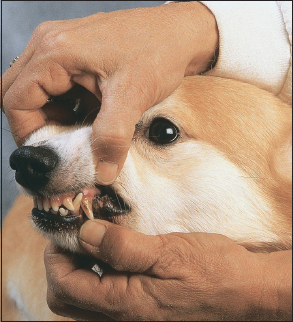

Once a year, your grown dog should visit the vet for an examination and vaccination boosters. Some vets recommend blood tests, thyroid level check and dental evaluation to accompany these annual visits. A thorough clinical evaluation by the vet can provide critical background information for your dog. Blood tests are often performed at one year of age, and dental examinations should be part of routine check-ups. In the long run, quality preventative care for your pet can save money, teeth and lives.
Veterinarians are consulted by dog owners for skin problems more than for any other group of diseases or maladies. Dogs’ skin is almost as sensitive as human skin and both can suffer almost the same ailments (though the occurrence of acne in most dogs is rare). For this reason, veterinary dermatology has developed into a specialty practiced by many veterinarians.
Since many skin problems have visual symptoms that are almost identical, it requires the skill of an experienced veterinary dermatologist to identify and cure many of the more severe skin disorders. Pet shops sell many treatments for skin problems, but most of the treatments are directed at symptoms and not the underlying problem(s). If your dog is suffering from a skin disorder, you should seek professional assistance as quickly as possible. As with all diseases, the earlier a problem is identified and treated, the more likely it is that the cure will be successful.
Veterinary dermatologists are currently researching a number of skin disorders that are believed to have hereditary bases. These inherited diseases are transmitted by both parents, who appear (phenotypically) normal but have a recessive gene for the disease, meaning that they carry, but are not affected by, the disease. These diseases pose serious problems to breeders because in some instances there is no method of identifying carriers. Often the secondary diseases associated with these skin conditions are even more debilitating than the disorders themselves, including cancers and respiratory problems.


Among the hereditary skin disorders, for which the mode of inheritance is known, are acrodermatitis, cutaneous asthenia (Ehlers-Danlos syndrome), sebaceous adenitis, cyclic hematopoiesis, dermatomyositis, IgA deficiency, color dilution alopecia and nodular dermatofibrosis. Some of these disorders are limited to one or two breeds and others affect a large number of breeds. All inherited diseases must be diagnosed and treated by a veterinary specialist.
Many of us are allergic to insect bites. The bites itch, erupt and may even become infected. Dogs have the same reaction to fleas, ticks and/or mites. When an insect lands on you, you have the chance to whisk it away with your hand. Unfortunately, when your dog is bitten by a flea, tick or mite, he can only scratch it away or bite it. By the time the dog has been bitten, the parasite has done some of its damage. It may also have laid eggs to cause further problems in the near future. The itching from parasite bites is probably due to the saliva injected into the site when the parasite sucks the dog’s blood.
Auto-immune skin conditions are commonly referred to as being allergic to yourself, while allergies are usually inflammatory reactions to an outside stimulus. Auto-immune diseases cause serious damage to the tissues that are involved.
The best known auto-immune disease is lupus, which affects people as well as dogs. The symptoms are variable and may affect the kidneys, bones, blood chemistry and skin. It can be fatal to both dogs and humans, though it is not thought to be transmissible. It is usually successfully treated with cortisone, prednisone or a similar corticosteroid, but extensive use of these drugs can have harmful side effects.
Don’t Eat the Daisies!
Many plants and flowers are beautiful to look at, but can be highly toxic if ingested by your dog. Reactions range from abdominal pain and vomiting to convulsions and death. If the following plants are in your home, remove them. If they are outside your house or in your yard, avoid accidents by making sure your dog is never left unsupervised in those locations.

Azalea
Belladonna
Bird of Paradise
Bulbs
Calla lily
Cardinal flower
Castor bean
Chinaberry tree
Daphne
Dumb cane
Dutchman’s breeches
Elephant’s ear
Hydrangea
Jack-in-the-pulpit
Jasmine
Jimsonweed
Larkspur
Laurel
Lily of the valley
Mescal bean
Mushrooms
Nightshade
Philodendron
Poinsettia
Prunus species
Tobacco
Yellow jasmine
Yews, Taxus species

“P” STANDS FOR PROBLEM
Urinary tract disease is a serious condition that requires immediate medical attention. Symptoms include urinating in inappropriate places or the need to urinate frequently in small amounts. Urinary-tract disease is most effectively treated with antibiotics. To help promote good urinary-tract health, owners must always be sure that a constant supply of fresh water is available to their pets.
Many dogs have a very poorly understood syndrome called acral lick granuloma. The manifestation of the problem is the dog’s tireless attack at a specific area of the body, almost always the legs or paws. The dog licks so intensively that he removes the hair and skin, leaving an ugly, large wound. Tiny protuberances, which are outgrowths of new capillaries, bead on the surface of the wound. Owners who notice their dogs’ biting and chewing at their extremities should have the vet determine the cause. If lick granuloma is identified, although there is no absolute cure, corticosteroids are the most common treatment.
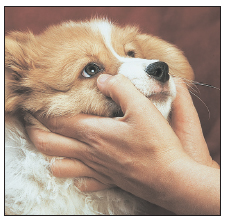
Examine your Pembroke’s eyes regularly. Any abnormalities like excessive tearing, mucus or cloudiness should be reported to the vet immediately.
Just as humans have hay fever, rose fever and other fevers with which they suffer during the pollinating season, many dogs suffer the same allergies. When the pollen count is high, your dog might suffer, but don’t expect him to sneeze and have a runny nose like a human would. Dogs react to pollen allergies the same way they react to fleas—they scratch and bite themselves.
Dogs, like humans, can be tested for allergens. Discuss the testing with your veterinary dermatologist.
FOOD ALLERGIES
Dogs are allergic to many foods that are best-sellers and highly recommended by breeders and veterinarians. Changing the brand of food that you buy may not eliminate the problem if the element to which the dog is allergic is contained in the new brand.
Recognizing a food allergy is difficult. Humans vomit or have rashes when they eat a food to which they are allergic. Dogs neither vomit nor (usually) develop rashes. They react in the same manner as they do to an airborne or flea allergy; they itch, scratch and bite, thus making the diagnosis extremely difficult. While pollen allergies and parasite bites are usually seasonal, food allergies are year-round problems.
A SKUNKY PROBLEM
Have you noticed your dog dragging his rump along the floor? If so, it is likely that his anal sacs are impacted or possibly infected. The anal sacs are small pouches located on both sides of the anus under the skin and muscles. They are about the size and shape of a grape and contain a foul-smelling liquid. Their contents are usually emptied when the dog has a bowel movement but, if not emptied completely, they will impact, which will cause your dog much pain. Fortunately, your veterinarian can tend to this problem easily by draining the sacs for the dog. Be aware that your dog might also empty his anal sacs in cases of extreme fright.
Food intolerance is the inability of the dog to completely digest certain foods. For example, puppies that may have done very well on their mother’s milk may not do well on cow’s milk. The result of this food intolerance may be loose bowels, passing gas and stomach pains. These are the only obvious symptoms of food intolerance and that makes diagnosis difficult, since these symptoms can be indicative of many different problems.
It is possible to handle food allergies and food intolerance yourself. Put your dog on a diet that he has never had. Obviously, if he has never eaten this new food, he can’t yet have been allergic or intolerant of it. Start with a single ingredient that is not in the dog’s diet at the present time. Ingredients like chopped beef or chicken are common in dogs’ diets, so try another quality protein source like fish, lamb or even rabbit. Keep the dog on this diet (with no additives) for a month. If the symptoms of food allergy or intolerance disappear, chances are your dog has a food allergy.

Your Pembroke’s coat tells volumes about his health. Proper nutrition and healthy skin shine through in a full, vibrant coat.
Don’t think that the single ingredient cured the problem. You still must find a suitable diet and ascertain which ingredient in the old diet was objectionable. This is most easily done by adding ingredients to the new diet one at a time. Let the dog stay on the modified diet for a month before you add another ingredient. Eventually, you will determine the ingredient that caused the adverse reaction.
An alternative method is to carefully study the ingredients in the diet to which your dog is allergic or intolerant. Identify the main ingredient in this diet and eliminate the main ingredient by buying a different food that does not have that ingredient. Keep experimenting until the symptoms disappear after one month on the new diet.
FATTY RISKS
Any dog of any breed can suffer from obesity. Studies show that nearly 30% of our dogs are overweight, primarily from high caloric intake and low energy expenditure. The hound and gundog breeds are the most likely affected, and females are at a greater risk of obesity than males. Pet dogs that are neutered are twice as prone to obesity as intact, whole dogs, although this is easily avoided with proper diet and exercise.
Regardless of breed, your dog should have a visible “waist” behind the rib cage and in front of the hind legs. There should be no fatty deposits on the hips or over the rump, and the abdomen should not be extended.
Veterinary specialists link obesity with respiratory problems, cardiac disease and liver dysfunction as well as low sperm count and abnormal estrous cycles in breeding animals. Other complications include musculoskeletal disease (including arthritis), decreased immune competence, diabetes mellitus, hypothyroidism, pancreatitis and dermatosis. Other studies have indicated that excess fat leads to heat stress, as obese dogs cannot regulate their body temperatures as well as normal-weight dogs.
Don’t be discouraged, however, if you discover that your dog has developed health problems or complications, weight-related or other, that require special attention. It is possible to tend to his medical needs. Veterinary specialists focus on areas such as cardiology, neurology and oncology. Veterinary medical associations require rigorous training and experience before granting certification in a specialty. Consulting a specialist may offer you greater peace of mind when seeking treatment for your dog.

FLEAS
Of all the problems to which dogs are prone, none is more well known and frustrating than fleas. Flea infestation is relatively simple to cure but difficult to prevent. Parasites that are harbored inside the body are a bit more difficult to eradicate but they are easier to control.
To control flea infestation, you have to understand the flea’s life cycle. Fleas are often thought of as a summertime problem, but centrally heated homes have changed the patterns and fleas can be found at any time of the year. The most effective method of flea control is a two-stage approach: one stage to kill the adult fleas, and the other to control the development of preadult fleas. Unfortunately, no single active ingredient is effective against all stages of the life cycle.
FLEA KILLER CAUTION—“POISON”
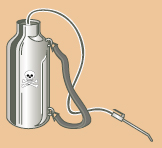
Flea-killers are poisonous. You should not spray these toxic chemicals on areas of a dog’s body that he licks, including his genitals and his face. Flea killers taken internally are a better answer, but check with your vet in case internal therapy is not advised for your dog.
During its life, a flea will pass through four life stages: egg, larva, pupa or nymph and adult. The adult stage is the most visible and irritating stage of the flea life cycle, and this is why the majority of flea-control products concentrate on this stage. The fact is that adult fleas account for only 1% of the total flea population, and the other 99% exist in pre-adult stages, i.e., eggs, larvae and nymphs. The pre-adult stages are barely visible to the naked eye.
Eggs are laid on the dog, usually in quantities of about 20 or 30, several times a day. The adult female flea must have a blood meal before each egg-laying session. When first laid, the eggs will cling to the dog’s hair, as the eggs are still moist. However, they will quickly dry out and fall from the dog, especially if the dog moves around or scratches. Many eggs will fall off in the dog’s favorite area or an area in which he spends a lot of time, such as his bed.
Once the eggs fall from the dog onto the carpet or furniture, they will hatch into larvae. This takes from one to ten days. Larvae are not particularly mobile and will usually travel only a few inches from where they hatch. However, they do have a tendency to move away from bright light and heavy traffic—under furniture and behind doors are common places to find high quantities of flea larvae.
The flea larvae feed on dead organic matter, including adult flea feces, until they are ready to change into adult fleas. Fleas will usually remain as larvae for around seven days. After this period, the larvae will pupate into protective pupae. While inside the pupae, the larvae will undergo metamorphosis and change into adult fleas. This can take as little time as a few days, but the adult fleas can remain inside the pupae waiting to hatch for up to two years. The pupae are signaled to hatch by certain stimuli, such as physical pressure—the pupae’s being stepped on, heat from an animal’s lying on the pupae or increased carbon-dioxide levels and vibrations—indicating that a suitable host is available.
Once hatched, the adult flea must feed within a few days. Once the adult flea finds a host, it will not leave voluntarily. It only becomes dislodged by grooming or the host animal’s scratching. The adult flea will remain on the host for the duration of its life unless forcibly removed.
Treating fleas should be a two-pronged attack. First, the environment needs to be treated; this includes carpets and furniture, especially the dog’s bedding and areas underneath furniture. The environment should be treated with a household spray containing an Insect Growth Regulator (IGR) and an insecticide to kill the adult fleas. Most IGRs are effective against eggs and larvae; they actually mimic the fleas’ own hormones and stop the eggs and larvae from developing into adult fleas. There are currently no treatments available to attack the pupa stage of the life cycle, so the adult insecticide is used to kill the newly hatched adult fleas before they find a host. Most IGRs are active for many months, while adult insecticides are only active for a few days.

EN GARDE: CATCHING FLEAS OFF GUARD!
Consider the following ways to arm yourself against fleas:
• Add a small amount of pennyroyal or eucalyptus oil to your dog’s bath. These natural remedies repel fleas.
• Supplement your dog’s food with fresh garlic (minced or grated) and a hearty amount of brewer’s yeast, both of which ward off fleas.
• Use a flea comb on your dog daily. Submerge fleas in a cup of bleach to kill them quickly.
• Confine the dog to only a few rooms to limit the spread of fleas in the home.
• Vacuum daily…and get all of the crevices! Dispose of the bag every few days until the problem is under control.
• Wash your dog’s bedding daily. Cover cushions where your dog sleeps with towels, and wash the towels often.
When treating with a household spray, it is a good idea to vacuum before applying the product. This stimulates as many pupae as possible to hatch into adult fleas. The vacuum cleaner should also be treated with an insecticide to prevent the eggs and larvae that have been collected in the vacuum bag from hatching.
The second stage of treatment is to apply an adult insecticide to the dog. Traditionally, this would be in the form of a collar or a spray, but more recent innovations include digestible insecticides that poison the fleas when they ingest the dog’s blood. Alternatively, there are drops that, when placed on the back of the dog’s neck, spread throughout the hair and skin to kill adult fleas.
Though not as common as fleas, ticks are found all over the tropical and temperate world. They don’t bite, like fleas; they harpoon. They dig their sharp proboscis (nose) into the dog’s skin and drink the blood. Their only food and drink is dog’s blood. Dogs can get Lyme disease, Rocky Mountain spotted fever, tick bite paralysis and many other diseases from ticks. They may live where fleas are found and they like to hide in cracks or seams in walls. They are controlled the same way fleas are controlled.
The American dog tick, Dermacentor variabilis, may well be the most common dog tick in many geographical areas, especially those areas where the climate is hot and humid. Most dog ticks have life expectancies of a week to six months, depending upon climatic conditions. They can neither jump nor fly, but they can crawl slowly and can range up to 16 feet to reach a sleeping or unsuspecting dog.
Just as fleas and ticks can be problematic for your dog, mites can also lead to an itchy nuisance. Microscopic in size, mites are related to ticks and generally take up permanent residence on their host animal—in this case, your dog! The term mange refers to any infestation caused by one of the mighty mites, of which there are six varieties that concern dog owners.
Demodex mites cause a condition known as demodicosis (sometimes called red mange or follicular mange), in which the mites live in the dog’s hair follicles and sebaceous glands in larger-than-normal numbers. This type of mange is commonly passed from the dam to her puppies and usually shows up on the puppies’ muzzles, though demodicosis is not transferable from one normal dog to another. Most dogs recover from this type of mange without any treatment, though topical therapies are commonly prescribed by the vet.
INSECT GROWTH REGULATOR (IGR)
Two types of products should be used when treating fleas—a product to treat the pet and a product to treat the home. Adult fleas represent less than 1% of the flea population. The pre-adult fleas (eggs, larvae and pupae) represent more than 99% of the flea population and are found in the environment; it is in the case of pre-adult fleas that products containing an Insect Growth Regulator (IGR) should be used in the home.
IGRs are a new class of compounds used to prevent the development of insects. They do not kill the insect outright, but instead use the insect’s biology against it to stop it from completing its growth. Products that contain methoprene are the world’s first and leading IGRs. Used to control fleas and other insects, this type of IGR will stop flea larvae from developing and protect the house for up to seven months.
The Cheyletiellosis mite is the hook-mouthed culprit associated with “walking dandruff,” a condition that affects dogs as well as cats and rabbits. This mite lives on the surface of the animal’s skin and is readily transferable through direct or indirect contact with an affected animal. The dandruff is present in the form of scaly skin, which may or may not be itchy. If not treated, this mange can affect a whole kennel of dogs and can be spread to humans as well.
The Sarcoptes mite causes intense itching on the dog in the form of a condition known as scabies or sarcoptic mange. The cycle of the Sarcoptes mite lasts about three weeks, and the mites live in the top layer of the dog’s skin (epidermis), preferably in areas with little hair. Scabies is highly contagious and can be passed to humans. Sometimes an allergic reaction to the mite worsens the severe itching associated with sarcoptic mange.
Ear mites, Otodectes cynotis, lead to otodectic mange, which most commonly affects the outer ear canal of the dog, though other areas can be affected as well. Dogs with ear-mite infestation commonly scratch at their ears, causing further irritation, and shake their heads. Dark brown droppings in the outer ear confirm the diagnosis. Your vet can prescribe a treatment to flush out the ears and kill any eggs in the ears. A complete month of treatment is necessary to cure the mange.
Two other mites, less common in dogs, include Dermanyssus gallinae (the poultry or red mite) and Eutrombicula alfreddugesi (the North American mite associated with trombiculidiasis or chigger infestation). The poultry mite frequently lives on chickens, but can transfer to dogs who spend time near farm animals. Chigger infestation affects dogs in the Central US who have exposure to woodlands. The types of mange caused by both of these mites are treatable by vets.
Most animals—fishes, birds and mammals, including dogs and humans—have worms and other parasites that live inside their bodies. According to Dr. Herbert R. Axelrod, the fish pathologist, there are two kinds of parasites: dumb and smart. The smart parasites live in peaceful cooperation with their hosts (symbiosis), while the dumb parasites kill their hosts. Most worm infections are relatively easy to control. If they are not controlled, they weaken the host dog to the point that other medical problems occur, but they do not kill the host as dumb parasites would.
DEER-TICK CROSSING
The great outdoors may be fun for your dog, but it also is a home to dangerous ticks. Deer ticks carry a bacterium known as Borrelia burgdorferi and are most active in the autumn and spring. When infections are caught early, penicillin and tetracycline are effective antibiotics, but, if left untreated, the bacteria may cause neurological, kidney and cardiac problems as well as long-term trouble with walking and painful joints.
The roundworms that infect dogs are known scientifically as Toxocara canis. They live in the dog’s intestines and shed eggs continually. It has been estimated that a dog produces about 6 or more ounces of feces every day. Each ounce of feces averages hundreds of thousands of roundworm eggs. There are no known areas in which dogs roam that do not contain roundworm eggs. The greatest danger of roundworms is that they infect people, too! It is wise to have your dog tested regularly for round-worms.
In young puppies, round-worms cause bloated bellies, diarrhea, coughing and vomiting, and are transmitted from the dam (through blood or milk). Affected puppies will not appear as animated as normal puppies. The worms appear spaghetti-like, measuring as long as 6 inches. Adult dogs can acquire round-worms through coprophagia (eating contaminated feces) or by killing rodents that carry round-worms.
Roundworm infection can kill puppies and cause severe problems in adults, as the hatched larvae travel to the lungs and trachea through the bloodstream. Cleanliness is the best preventative for roundworms. Always pick up after your dog and dispose of feces in appropriate receptacles.
In the United States, dog owners have to be concerned about four different species of hookworm, the most common and most serious of which is Ancylostoma caninum, which prefers warm climates. The others are Ancylostoma braziliense, Ancylostoma tubaeforme and Uncinaria stenocephala, the latter of which is a concern to dogs living in the Northern US and Canada, as this species prefers cold climates. Hookworms are dangerous to humans as well as to dogs and cats, and can be the cause of severe anemia due to iron deficiency. The worm uses its teeth to attach itself to the dog’s intestines and changes the site of its attachment about six times per day. Each time the worm repositions itself, the dog loses blood and can become anemic. Ancylostoma caninum is the most likely of the four species to cause anemia in the dog.
Symptoms of hookworm infection include dark stools, weight loss, general weakness, pale coloration and anemia, as well as possible skin problems. Fortunately, hookworms are easily purged from the affected dog with a number of medications that have proven effective. Discuss these with your vet. Most heartworm preventatives include a hookworm insecticide as well.
Owners also must be aware that hookworms can infect humans, who can acquire the larvae through exposure to contaminated feces. Since the worms cannot complete their life cycle on a human, the worms simply infest the skin and cause irritation. This condition is known as cutaneous larva migrans syndrome. As a preventative, use disposable gloves or a “poop-scoop” to pick up your dog’s droppings and prevent your dog (or neighborhood cats) from defecating in children’s play areas.
There are many species of tapeworm, all of which are carried by fleas! The most common tapeworm affecting dogs is known as Dipylidium caninum. The dog eats the flea and starts the tapeworm cycle. Humans can also be infected with tapeworms—so don’t eat fleas! Fleas are so small that your dog could pass them onto your hands, your plate or your food and thus make it possible for you to ingest a flea that is carrying tapeworm eggs.
While tapeworm infection is not life-threatening in dogs (smart parasite!), it can be the cause of a very serious liver disease for humans. About 50% of the humans infected with Echinococcus multilocularis, a type of tapeworm that causes alveolar hydatid, perish.
In North America, whipworms are counted among the most common parasitic worms in dogs. The whip-worm’s scientific name is Trichuris vulpis. These worms attach themselves in the lower parts of the intestine, where they feed. Affected dogs may only experience upset tummies, colic and diarrhea. These worms, however, can live for months or years in the dog, beginning their larval stage in the small intestine, spending their adult stage in the large intestine and finally passing infective eggs through the dog’s feces. The only way to detect whipworms is through a fecal examination, though this is not always foolproof. Treatment for whipworms is tricky, due to the worms’ unusual life-cycle pattern, and very often dogs are reinfected due to exposure to infective eggs on the ground. The whipworm eggs can survive in the environment for as long as five years; thus, cleaning up droppings in your own backyard as well as in public places is absolutely essential for sanitation purposes and the health of your Pembroke Welsh Corgi and others.
DO NOT MIX
Never mix parasite-control products without first consulting your vet. Some products can become toxic when combined with others and can cause fatal consequences.
NOT A DROP TO DRINK
Never allow your dog to swim in polluted water or public areas where water quality can be suspect. Even perfectly clear water can harbor parasites, many of which can cause serious to fatal illnesses in canines. Areas inhabited by waterfowl and other wildlife are especially dangerous.
Though less common than round-worms, hookworms and those previously mentioned, threadworms concern dog owners in the Southwestern US and Gulf Coast area where the climate is hot and humid. Living in the small intestine of the dog, this worm measures a mere 2 millimeters and is round in shape. Like that of the whipworm, the threadworm’s life cycle is very complex and the eggs and larvae are passed through the feces. A deadly disease in humans, Strongyloides readily infects people, and the handling of feces is the most common means of transmission. Threadworms are most often seen in young puppies; bloody diarrhea and pneumonia are symptoms. Sick puppies must be isolated and treated immediately; veterinarians recommend a follow-up treatment one month later.
ROUNDWORMS
Average-size dogs can pass 1,360,000 roundworm eggs every day. For example, if there were only 1 million dogs in the world, the world would be saturated with thousands of tons of dog feces. These feces would contain around 15,000,000,000 roundworm eggs.
Up to 31% of home yards and children’s sand boxes in the US contain roundworm eggs.
Flushing dog’s feces down the toilet is not a safe practice because the usual sewage treatments do not destroy roundworm eggs.
Infected puppies start shedding roundworm eggs at three weeks of age. They can be infected by their mother’s milk.
Heartworms are thin, extended worms up to 12 inches long, which live in a dog’s heart and the major blood vessels surrounding it. Dogs may have up to 200 worms. Symptoms may be loss of energy, loss of appetite, coughing, the development of a pot belly and anemia.
Heartworms are transmitted by mosquitoes. The mosquito drinks the blood of an infected dog and takes in larvae with the blood. The larvae, called microfilariae, develop within the body of the mosquito and are passed on to the next dog bitten after the larvae mature. It takes two to three weeks for the larvae to develop to the infective stage within the body of the mosquito. Dogs are usually treated at about six weeks of age and maintained on a prophylactic dose given monthly.
Blood testing for heartworms is not necessarily indicative of how seriously your dog is infected. Although this is a dangerous disease, it is not easy for a dog to be infected. Discuss the various preventatives with your veterinarian, as there are many different types now available. Together you can decide on a safe course of prevention for your Pembroke Welsh Corgi.
an alternative to conventional medicine

“Less is Most”
Using this principle, the strength of a homeopathic remedy is measured by the number of serial dilutions that were undertaken to create it. The greater the number of serial dilutions, the greater the strength of the homeopathic remedy. The potency of a remedy that has been made by making a dilution of 1 part in 100 parts (or 1/100) is 1c or 1cH. If this remedy is subjected to a series of further dilutions, each one being 1/100, a more dilute and stronger remedy is produced. If the remedy is diluted in this way six times, it is called 6c or 6cH. A dilution of 6c is 1 part in 1,000,000,000,000. In general, higher potencies in more frequent doses are better for acute symptoms and lower potencies in more infrequent doses are more useful for chronic, long-standing problems.
Holistic medicine means treating the whole animal as a unique, perfect, living being. Generally, holistic treatments do not suppress the symptoms that the body naturally produces, as do most medications prescribed by conventional doctors and vets. Holistic methods seek to cure disease by regaining balance and harmony in the patient’s environment. Some of these methods include use of nutritional therapy, herbs, flower essences, aromatherapy, acupuncture, massage, chiropractic and, of course, the most popular holistic approach, homeopathy.
Homeopathy is a theory or system of treating illness with small doses of substances which, if administered in larger quantities, would produce the symptoms that the patient already has. This approach is often described as “like cures like.” Although modern veterinary medicine is geared toward the “quick fix,” homeopathy relies on the belief that, given the time, the body is able to heal itself and return to its natural, healthy state.
Choosing a remedy to cure a problem in our dogs is the difficult part of homeopathy. Consult with your vet for a professional diagnosis of your dog’s symptoms. Often these symptoms require immediate conventional care. If your vet is willing and knowledgeable, you may attempt a homeopathic remedy. Be aware that cortisone prevents homeopathic remedies from working. There are hundreds of possibilities and combinations to cure many problems in dogs, from basic physical problems such as excessive shedding, fleas or other parasites, unattractive doggy odor, bad breath, upset tummy, obesity, dry, oily or dull coat, diarrhea, ear problems or eye discharge (including tears and dry or mucousy matter), to behavioral abnormalities such as fear of loud noises, habitual licking, poor appetite, excessive barking and various phobias. From alumina to zincum metallicum, the remedies span the planet and the imagination…from flowers and weeds to chemicals, insect droppings, diesel smoke and volcanic ash.
Using “Like to Treat Like”
Unlike conventional medicines that suppress symptoms, homeopathic remedies treat illnesses with small doses of substances that, if administered in larger quantities, would produce the symptoms that the patient already has. While the same homeopathic remedy can be used to treat different symptoms in different dogs, here are some interesting remedies and their uses.
Apis Mellifica
(made from honey bee venom) can be used for allergies or to reduce swelling that occurs in acutely infected kidneys.
Diesel Smoke
can be used to help control travel sickness.
Calcarea Fluorica
(made from calcium fluoride, which helps harden bone structure) can be useful in treating hard lumps in tissues.
Natrum Muriaticum
(made from common salt, sodium chloride) is useful in treating thin, thirsty dogs.
Nitricum Acidum
(made from nitric acid) is used for symptoms you would expect to see from contact with acids, such as lesions, especially where the skin joins the linings of body orifices or openings such as the lips and nostrils.
Symphytum
(made from the herb Knitbone, Symphytum officianale) is used to encourage bones to heal.
Urtica Urens
(made from the common stinging nettle) is used in treating painful, irritating rashes.


Recognizing a Sick Dog
Unlike colicky babies and cranky children, our canine kids cannot tell us when they are feeling ill. Therefore, there are a number of signs that owners can identify to know that their dogs are not feeling well.
Take note for physical manifestations such as:
• unusual, bad odor, including bad breath
• excessive shedding
• wax in the ears, chronic ear irritation
• oily, flaky, dull haircoat
• mucus, tearing or similar discharge in the eyes
• fleas or mites
• mucus in stool, diarrhea
• sensitivity to petting or handling
• licking at paws, scratching face, etc.
Keep an eye out for behavioral changes as well including:
• lethargy, idleness
• lack of patience or general irritability
• lack of appetite
• phobias (fear of people, loud noises, etc.)
• strange behavior, suspicion, fear
• coprophagia
• more frequent barking
• whimpering, crying

Get Well Soon
You don’t need a DVM to provide good TLC to your sick or recovering dog, but you do need to pay attention to some details that normally wouldn’t bother him. The following tips will aid Fido’s recovery and get him back on his paws again:
• Keep his space free of irritating smells, like heavy perfumes and air fresheners.
• Rest is the best medicine! Avoid harsh lighting that will prevent your dog from sleeping. Shade him from bright sunlight during the day and dim the lights in the evening.
• Keep the noise level down. Animals are more sensitive to sound when they are sick.
• Be attentive to any necessary temperature adjustments. A dog with a fever needs a cool room and cold liquids. A bitch that is whelping or recovering from surgery will be more comfortable in a warm room, consuming warm liquids and food.
• You wouldn’t send a sick child back to school early, so don’t rush your dog back into a full routine until he seems absolutely ready.
CDS: COGNITIVE DYSFUNCTION SYNDROME
“Old-Dog Syndrome”
There are many ways for you to evaluate old-dog syndrome. Veterinarians have defined CDS (cognitive dysfunction syndrome) as the gradual deterioration of cognitive abilities. These are indicated by changes in the dog’s behavior. When a dog changes his routine response, and maladies have been eliminated as the cause of these behavioral changes, then CDS is the usual diagnosis.
More than half the dogs over eight years old suffer from some form of CDS. The older the dog, the more chance he has of suffering from CDS. In humans, doctors often dismiss the CDS behavioral changes as part of “winding down.”
There are four major signs of CDS: frequent potty accidents inside the home, sleeping much more or much less than normal, acting confused and failing to respond to social stimuli.
SYMPTOMS OF CDS
FREQUENT POTTY ACCIDENTS
• Urinates in the house.
• Defecates in the house.
• Doesn’t signal that he wants to go out.
SLEEP PATTERNS
• Moves much more slowly.
• Sleeps more than normal during the day.
• Sleeps less during the night.
CONFUSION
• Goes outside and just stands there.
• Appears confused with a faraway look in his eyes.
• Hides more often.
• Doesn’t recognize friends.
• Doesn’t come when called.
• Walks around listlessly and without a destination.
FAILURE TO RESPOND TO SOCIAL STIMULI
• Comes to people less frequently, whether called or not.
• Doesn’t tolerate petting for more than a short time.
• Doesn’t come to the door when you return home.